This section gives an overview on air pollution control in Hong Kong. For more information, please visit Air Pollution Control Strategies, Air Quality Objectives, AQHI & Air Quality, Indoor Air Quality, Ozone Layer Protection Ordinance, Asbestos Control, Problems & Solutions, Public Consultation, Data & Statistics, Study Reports and Guidelines & References.
AN OVERVIEW ON AIR QUALITY AND AIR POLLUTION CONTROL IN HONG KONG
THE AIR QUALITY IN HONG KONG
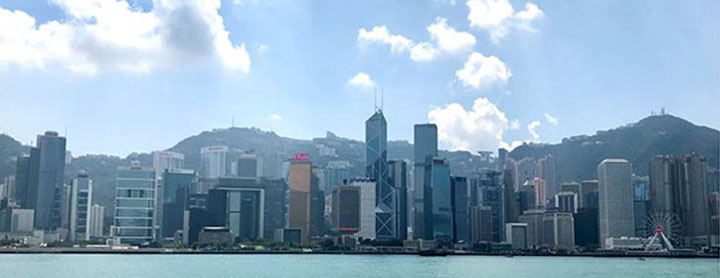
Hong Kong has been facing two air pollution issues, namely local street-level pollution and regional smog problem. Commercial vehicles are the main source of street-level pollution. Smog, however, is caused by a combination of pollutants from motor vehicles, marine vessels, industry and power plants both in Hong Kong and in the Pearl River Delta (PRD) region. Because of these air pollution problems, Hong Kong has yet to fully achieve the current Air Quality Objectives [see Air Quality Objectives Compliance Status]
The Hong Kong Special Administrative Region Government gives high priority to controlling both local air pollution and regional smog problems. The main strategies include:
- Implementing a wide range of measures to control emissions of air pollutants from motor vehicles, marine vessels, power plants, and industrial and commercial processes locally.
- Working with Guangdong Provincial Authorities to implement a joint plan to tackle the regional smog problem.
To continuously improve air quality, the Government announced the Clean Air Plan for Hong Kong 2035 in June 2021, setting out the vision of “Healthy Living • Low-carbon Transformation • World Class”, leading Hong Kong to be a more liveable city with air quality on par with major international cities by 2035, and advancing towards the long-term target of having Hong Kong’s air quality fully meeting the ultimate targets under the World Health Organization Global Air Quality Guidelines.
The structure within the Government for air policy development and provision of services in air quality management is shown in the table.
Reducing Emissions from Vehicles
Improving air quality at the roadside to better protect public health has always been a key environmental priority of the Government. Commercial vehicles, including goods vehicles, buses, light buses and taxis, are key emission sources of air pollutants at the roadside. Hence, commercial vehicles have all along been a major target of the Government’s measures to improve roadside air quality.
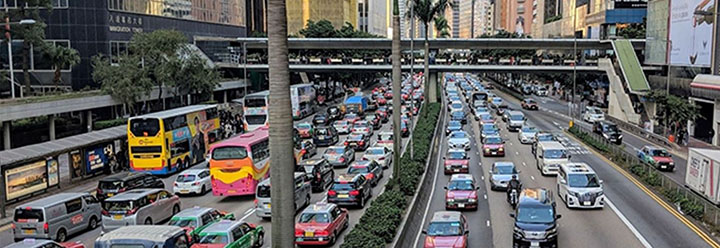
The Government has been implementing a series of vehicle emission control measures in recent years, including an incentive-cum-regulatory programme to phase out old diesel commercial vehicles, replacement of catalytic converters and oxygen sensors of liquefied petroleum gas (LPG) taxis and light buses, strengthening emissions control on LPG and petrol vehicles, retrofitting Euro II and III diesel franchised buses with selective catalytic reduction devices (SCR) and the adoption of tighter vehicle emission standards, etc.. Thanks to these measures, the concentrations of key air pollutants at the roadside, namely respirable suspended particulates (PM10) and nitrogen dioxide (NO2), have reduced by 38% and 41% respectively from 2012 to 2021. For details on the vehicle emission control measures, please see Cleaning the Air at Street Level.
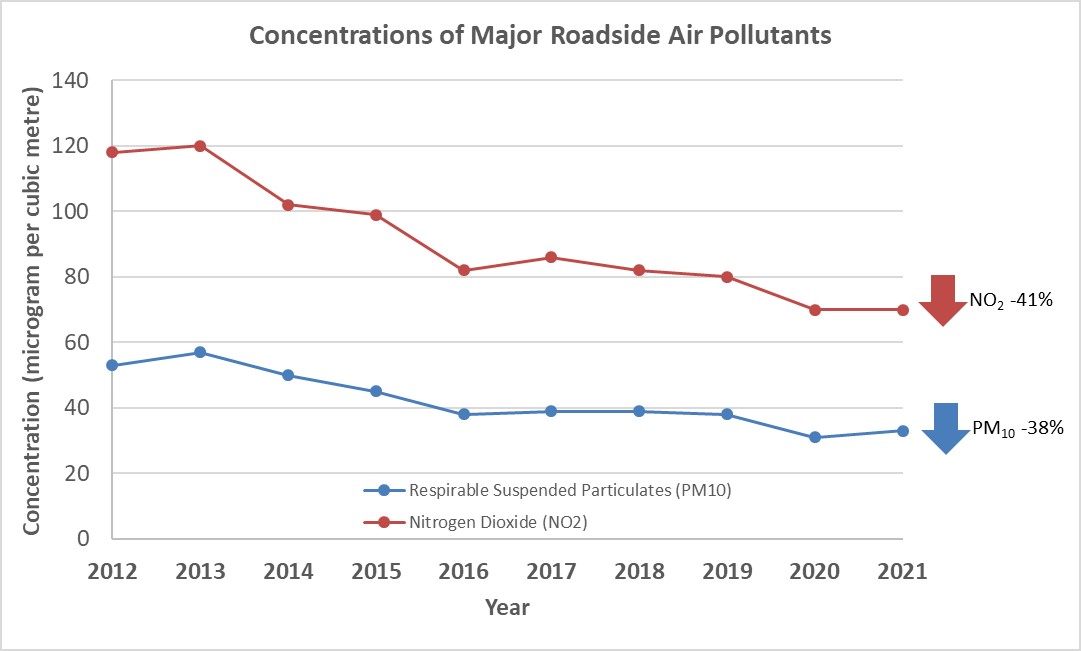
Reducing Emissions from Vessels
To control emissions from local vessels, Hong Kong has capped the sulphur content of locally supplied marine light diesel at 0.05% since 1 April 2014. The Government has led by example by powering its fleet with Euro V diesel (sulphur content not exceeding 0.001%). On 1 July 2015, Hong Kong became the first port in Asia mandating ocean-going vessels to switch to fuel with sulphur content not exceeding 0.5% while at berth.
Also, Hong Kong has been collaborating with the Mainland to jointly implement marine emission control for the domestic emission control area (DECA) along Mainland’s coastal waters. Starting from 1 January 2019, all vessels within Hong Kong waters are required to use compliant fuel (including fuel with sulphur content not exceeding 0.5% or liquefied natural gas), irrespective of whether they are sailing or berthing.
Reducing Emissions from Industrial Sources and Power Plants
The Air Pollution Control Ordinance (the Ordinance) and its subsidiary regulations provide for the control of emissions from power plants, industrial and commercial sources, construction activities, open burning, asbestos-containing materials, petrol filling stations and dry-cleaning machines.
A regulation was introduced in 1990 to limit the sulphur content of industrial fuel. Starting from 2008, all commercial and industrial processes are required to use ultra low sulphur diesel (with sulphur content not more than 0.005% by weight).
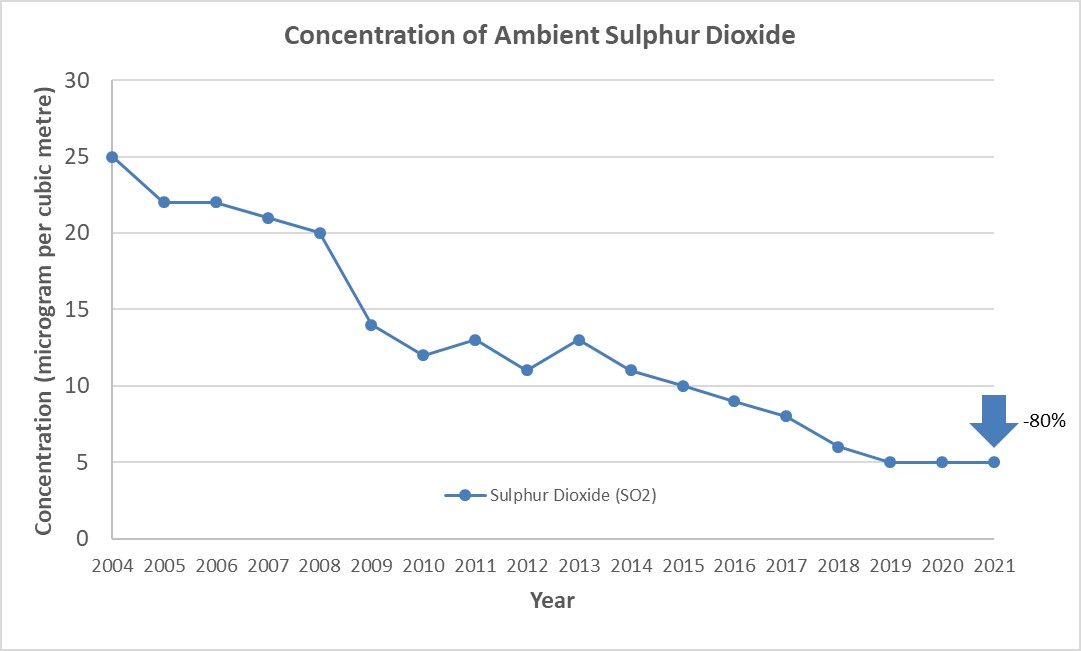
Electricity generation is a major source of air pollution in Hong Kong. A series of measures have been implemented to control emissions from power plants which include prohibiting the installation of new coal-fired generating unit since 1997, adopting best practicable means for emission control, encouraging the use of natural gas for electricity generation, imposing stringent emission caps on power plants through their specified process licences since 2005, and incentivising the two local power companies to promote the development of renewable energy for electricity generation through the Scheme of Control Agreement. In 2008, we also stipulated the stringent emission caps for 2010 and beyond through a Technical Memorandum (TM). In order to meet the stringent emission caps, the power companies had adopted additional emission reduction measures, including installing flue gas desulphurisation (FGD) systems and denitrification systems for coal-fired units, and increasing the use of low-emission coal and natural gas for electricity generation. In 2010, we reviewed the First TM and tightened the emission caps for the power sector from 2015 onwards, the compliance with which would require the power sector to maximise the use of existing gas-fired generation units and prioritise coal-fired generation units retrofitted with emission abatement facilities. Since then, we conducted eight more reviews on the TM and, after each review, issued a new TM to supersede the old one to further tighten the emission caps. The Ninth TM was issued in June 2021 and would tighten the emission caps of sulphur dioxide (SO2), nitrogen oxides (NOx) and PM10 by around 70% to 90% from 2026 onwards as compared with the emission caps set under the First TM.
As a result of the stringent control measures implemented over the past years, emissions from power plants have been substantially reduced over the years even though demand for power has increased. For more details, please visit Air Pollution Control Strategies.
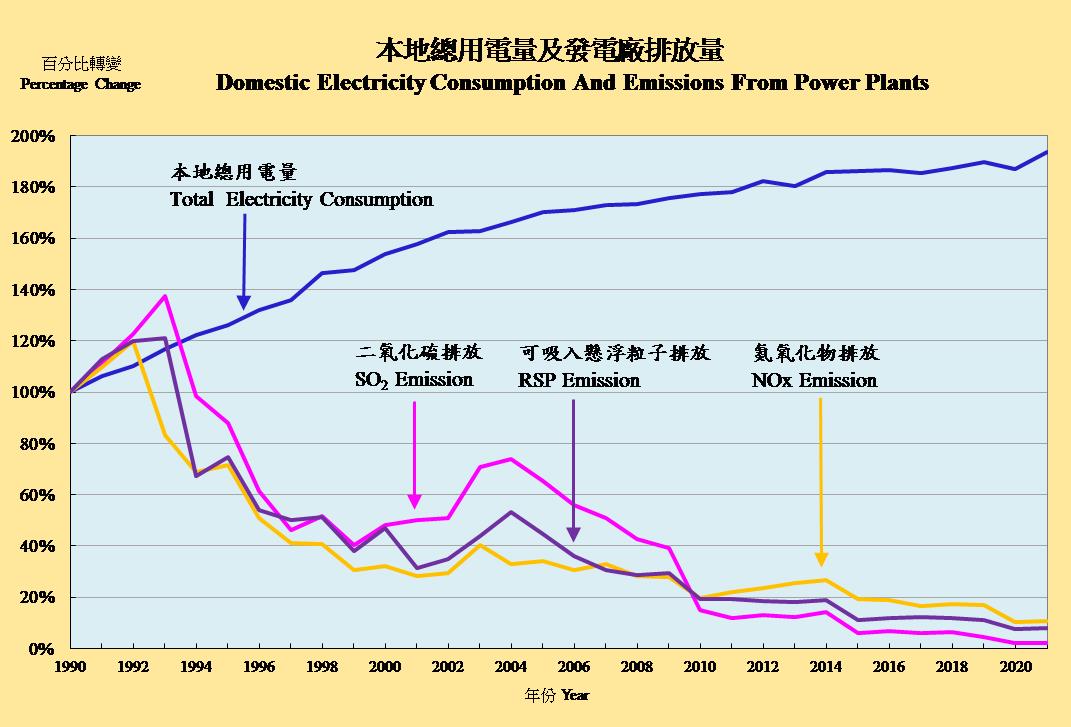
Reducing Volatile Organic Compound (VOC) Emissions
VOCs are found in a lot of products such as paints, printing inks, consumer products, organic solvents and petroleum products. The use of these products releases VOCs which cause air pollution and smog (VOCs and Smog). To reduce VOC emissions, the Government has implemented control measures to recover petrol vapour released during petrol unloading and refueling at petrol stations, and to tighten emissions standards of motor vehicles in line with the European Union standards. The VOC Regulation, effective from 1 April 2007 under the Ordinance, controls the VOC content of architectural paints, printing inks and six broad categories of consumer products (i.e. air fresheners, hairsprays, multi-purpose lubricants, floor wax strippers, insecticides and insect repellents); and requires emission reduction devices to be installed on specified types of printing machines. The regulation was amended in 2009 to extend the control to other VOC-containing products, including adhesives, sealants, vehicle refinishing paints, and marine vessel and pleasure craft paints, starting from 1 January 2010 in phases. In 2017, the regulation was further amended to cover fountain solutions and printing machine cleaning agents with effect from 1 January 2018.
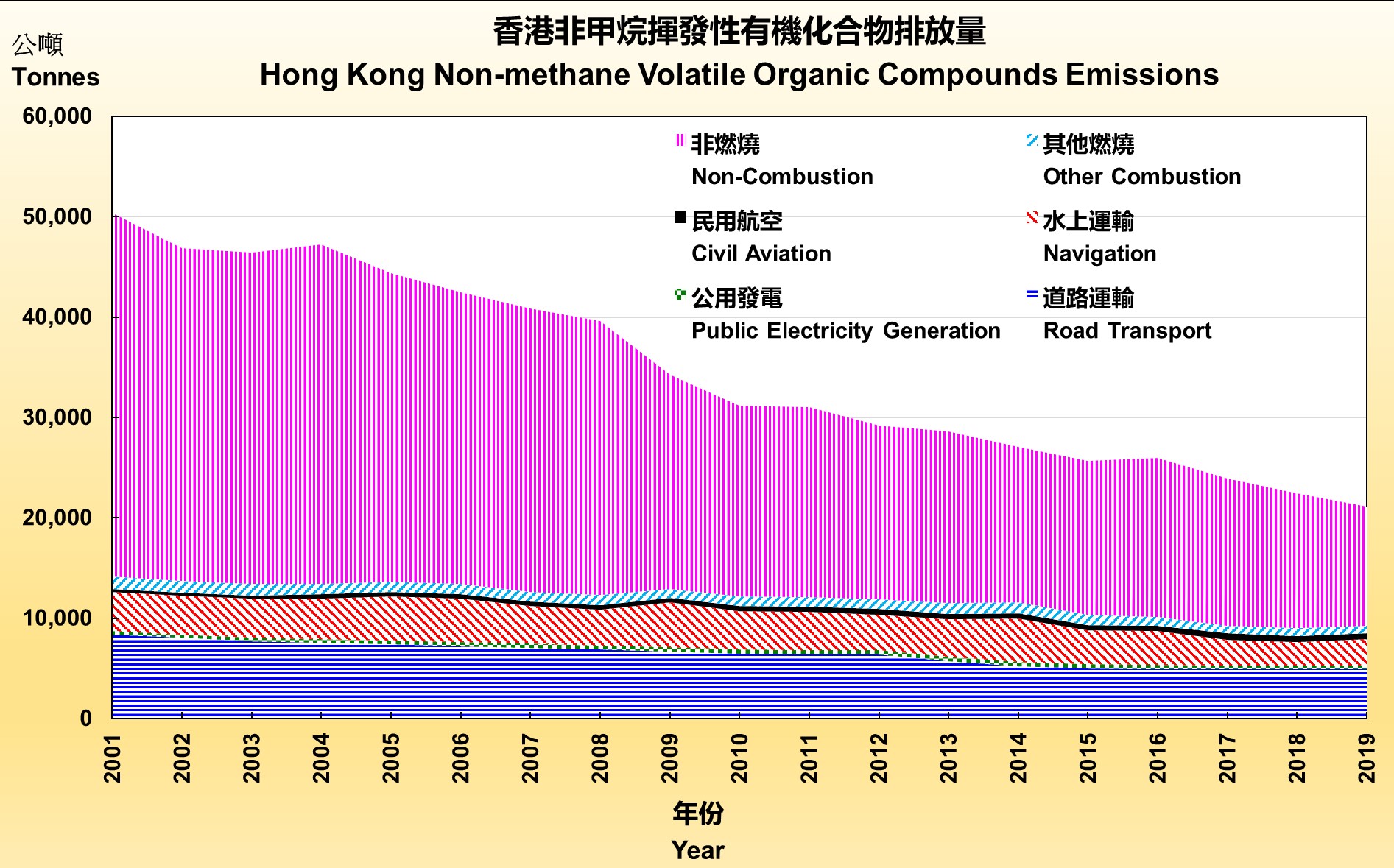
Tackling Regional Air Pollution
Motor vehicles, vessels, industry and power plants in Hong Kong and the PRD region all contribute to a regional air pollution problem, commonly known as smog. The Hong Kong and Guangdong governments are working on a joint plan to reduce the total amount of emissions with the aim to achieve good air quality for the Greater Bay Area in the long term. Thanks to the joint efforts of the two governments in cutting emissions in the region, such as retrofitting power plants with emission reduction devices, phasing out highly polluting industrial plants in the PRD, introducing cleaner motor vehicle fuels and motor vehicles, etc., the air quality in the region has improved over the years. According to the air quality monitoring results from the PRD Regional Air Quality Monitoring Network, the average annual concentrations of SO2, NO2 and PM10 in the PRD Region decreased by 86%, 43% and 49% respectively in 2020 compared to the figures of 2006 when the Network started to operate.
For more details, please visit Air Pollution Control Strategies.
OUR GLOBAL OBLIGATION
Ozone Layer Protection
The Ozone Layer Protection Ordinance enables Hong Kong to fully comply with international obligations under the Montreal Protocol to phase out ozone depleting substances, and to control the import and export of these substances. For details, please visit Ozone Layer Protection.
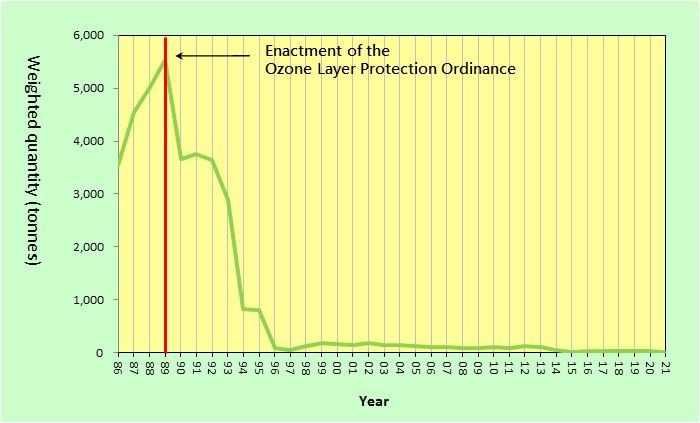
AIR QUALITY INFORMATION
The EPD monitors PM10, NOx and other pollutants in the air. It provides updates on Air Quality Health Index (AQHI) every hour, and releases annual reports on air quality. For details, please visit AQHI & Air Quality.
INDOOR AIR QUALITY
To promote healthy indoor environments and raise public awareness of the importance of indoor air quality (IAQ), the EPD has set up an Indoor Air Quality Information Centre. The centre provides general information on IAQ as well as practical measures for improving IAQ. For details, please visit Indoor Air Quality.
WHAT YOU CAN DO
Citizens can help reduce air pollution by choosing public instead of personalised transport and doing such things as turning off electric lights and appliances when not in use. For more tips on reducing air pollution, please refer to Help Clean the Air.
Industry, developers and others can also play their parts by observing air pollution control laws and exercising good practices in their operations. Please refer to Guidelines & References for a full account of compliance guides and good practices.